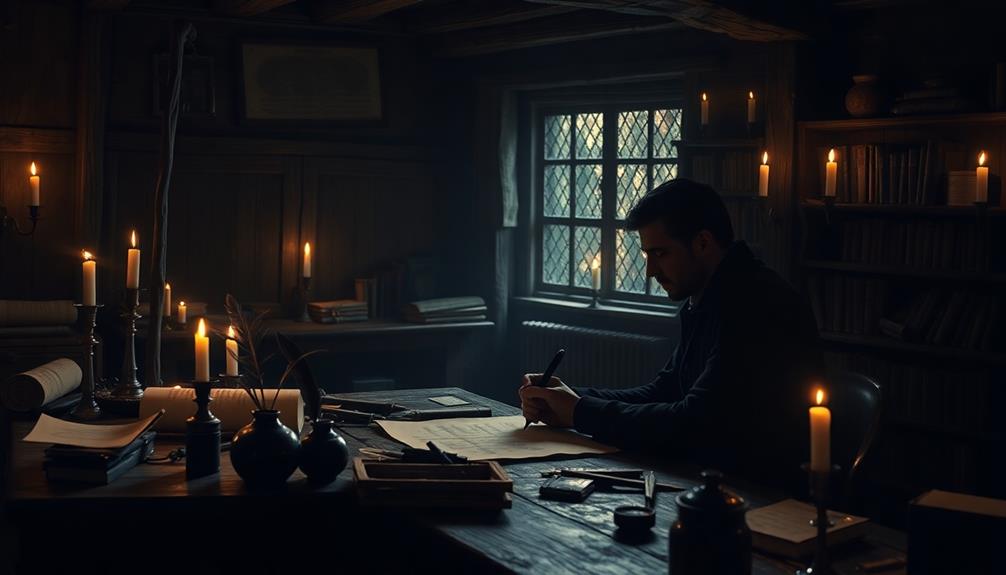You'll find that 'The Pillars of the Earth' was written by Ken Follett, a true master of storytelling. This epic novel immerses you in 12th-century England, focusing on the ambitious project of building a Gothic cathedral. Follett's own upbringing, influenced by a Puritan background, sparked his fascination with architecture and narrative. Themes of love, power struggles, and resilience permeate the story. Rich character development draws you into the lives of memorable figures like Tom Builder and Lady Aliena. Discover more about Follett's inspirations and the lasting impact of this literary masterpiece as you explore further.
Overview of the Novel
Set against the backdrop of 12th-century England, "The Pillars of the Earth" immerses you in the ambitious quest to build a Gothic cathedral in the fictional town of Kingsbridge.
Written by Ken Follett, this historical fiction novel brings to life the complexities of medieval life through a rich tapestry of characters. You'll encounter master builder Tom, noblewoman Aliena, and monk Philip, whose intertwined lives create an enthralling narrative that spans approximately 40 years.
The novel's intricate plotting and rich historical detail can be compared to other acclaimed works in the genre, such as the enthralling narrative of "The Lost Apothecary", highlighting the struggles and aspirations of individuals maneuvering a complex society.
As the story unfolds, you witness the struggles and triumphs of these characters against a backdrop of love, loss, ambition, and power struggles.
The building of the cathedral serves as both a literal and metaphorical foundation for their lives, reflecting the societal changes and challenges of the time. Follett's meticulous attention to historical detail enriches the reading experience, making it a celebrated work within the genre, with over 170 million copies sold worldwide.
The epic scope of "The Pillars of the Earth" has also led to its adaptation into a successful miniseries, further solidifying its cultural impact and relevance in today's world.
Ken Follett's Early Life
Ken Follett's early life in Cardiff, Wales, shaped his worldview and creativity considerably.
The historical narratives he encountered, such as the resilience showcased in Louis Zamperini's survival story, influenced his understanding of human strength and determination.
Growing up in a strict religious environment limited his exposure to traditional architecture, but his later visits to iconic structures sparked a deep interest in the craft.
These childhood influences and architectural inspirations would play an essential role in his writing, particularly in "The Pillars of the Earth."
Childhood Influences
Growing up in a strict Puritan group known as the Plymouth Brethren, Follett had limited exposure to the wider world, which profoundly shaped his early life. His childhood was marked by a lack of cultural and architectural influences, leaving him with a yearning for stories beyond the boundaries of his upbringing. This yearning ignited a passion for storytelling, fostering a narrative style that resonates in his later works.
While he mightn't have encountered medieval architecture during his formative years, the seeds of that interest were sown later when he visited the Peterborough Cathedral in his twenties. This experience became pivotal, sparking his imagination and influencing his writing, particularly in "The Pillars of the Earth."
Despite initial setbacks, including multiple rejections when he first attempted to write the novel in 1976, Follett's resolve flourished. His early career as a reporter honed his skills in narrative structure, which would prove invaluable.
The combination of his restrictive childhood and newfound exposure to literature and architecture shaped Follett's distinctive voice, allowing him to weave complex tales of resilience and creation throughout his historical novels.
Architectural Inspiration
The early constraints of Follett's upbringing left a gap that architecture would later fill, transforming his creative vision. Growing up in a strict Puritan group, he'd limited exposure to the grandeur of church architecture.
However, in his twenties, living in London opened the door to his architectural inspiration. Visiting majestic cathedrals, especially Peterborough Cathedral, ignited his passion for building and the complexities of medieval cathedral construction.
Here are some key factors that shaped this inspiration:
- Follett's initial sketches for "The Pillars of the Earth" emerged in 1976, reflecting his fascination with Gothic architecture.
- He consulted historian Jean Gimpel to guarantee historical accuracy in the cathedral construction depicted in his narrative.
- The intricate details woven into the fictional Kingsbridge's story mirror the architectural nuances that captivated him.
These experiences greatly influenced Follett's vivid portrayal of the cathedral's construction, allowing readers to immerse themselves in the world of medieval architecture.
The result is a compelling narrative that showcases not just the story of a building, but the very essence of artistic creation itself.
Themes in Follett's Work

Throughout his works, particularly in "The Pillars of the Earth," Follett masterfully weaves together intricate themes that resonate deeply with readers. One prominent theme is human resilience, vividly portrayed through characters like Tom Builder and Prior Philip, who face immense challenges while constructing the cathedral in Kingsbridge. Their determination reflects the broader struggle of the community against adversity, showcasing the power of collective effort, similar to how collective action in resistance movements exemplified unity against oppression during World War II.
Follett also explores the conflict between church and state, illustrating how political power struggles impact the lives of his characters. The cathedral emerges as a symbol of hope and unity, serving as a reminder of the transformative potential of art and architecture.
Additionally, you'll find strong female characters like Aliena and Ellen, who exemplify strength and determination in a male-dominated society. Their journeys highlight the fight for personal agency and the complexities of their roles.
The narrative doesn't shy away from moral dilemmas, exploring the duality of human nature. Characters embody both virtuous and flawed traits, enhancing the story's depth and engagement with themes of good versus evil. Each layer invites you to reflect on the human experience through Follett's compelling lens.
Key Characters and Their Roles
Follett's exploration of themes is brought to life through a cast of compelling characters, each playing a pivotal role in the story of "The Pillars of the Earth."
Tom Builder stands out as the master builder, whose vision and determination drive the ambitious project of constructing the Kingsbridge Cathedral. This ambition echoes the resilience seen in characters like Francie Nolan from a poignant immigrant narrative that highlights the struggles of urban poverty.
Alongside him, Prior Philip emerges as the dedicated monk, working to reform the monastery and support the cathedral's construction, often caught between faith and ambition.
Lady Aliena, the strong-willed daughter of an earl, fiercely pursues the reclamation of her family's legacy while maneuvering through the treacherous political landscape, ultimately becoming a vital ally for Tom.
Meanwhile, Jack Jackson, Tom's son, showcases his artistic talents as a stone carver, contributing greatly to the cathedral's creation.
Opposing them is William Hamleigh, the primary antagonist, whose ruthless ambition represents the corrupting power of greed in feudal society.
Key characters exemplify the intricate web of relationships and conflicts that drive the narrative:
- Tom Builder: Master builder with a vision.
- Prior Philip: Monk balancing faith and ambition.
- Lady Aliena: Determined noblewoman reclaiming her legacy.
Reader Reception and Impact

When you read "The Pillars of the Earth," you can't help but feel a strong emotional connection to the characters and their struggles.
The depth of character development and intricate plotlines echo the elements found in classic literature, such as in David Copperfield's transformative journey.
However, opinions about the book often split; while many praise its depth, others criticize its length and graphic content.
This polarized reception highlights the novel's impact, making it a topic of discussion among readers.
Emotional Engagement Levels
Readers often find themselves deeply immersed in the emotional landscape of "The Pillars of the Earth," as the novel evokes a wide range of feelings through its rich character development and intricate plot.
The complexity of characters like Tom Builder and Lady Aliena fosters a strong emotional engagement, allowing you to experience their triumphs and struggles intimately. This connection often leads to passionate reactions and a deeper investment in their fates.
- The themes of resilience highlight the characters' ability to overcome adversity, resonating with readers and inspiring hope.
- Emotional highs and lows throughout the plot create a rollercoaster of feelings, enhancing reader satisfaction.
- Content warnings for graphic scenes prepare you for the intense emotional experiences that shape the narrative.
With an impressive average rating of 4.34 based on numerous reviews, it's clear that many readers appreciate the depth and intricacy of the story.
While some critique the book's length, the emotional impact and character-driven narrative often outweigh any perceived filler, making "The Pillars of the Earth" a memorable reading experience.
Polarized Reader Perspectives
With an impressive average rating of 4.34 from over 781,000 ratings, "The Pillars of the Earth" showcases a stark division in reader perspectives. Ken Follett's novel has captivated many, creating deep emotional connections that fuel a dedicated fanbase. Readers often praise its intricate plot and character development, highlighting how these elements enrich their experience of historical fiction.
However, the reception isn't universally positive. Some readers criticize the book's length and what they see as filler content, contributing to a polarized reception. These differing opinions underscore the varied expectations and tastes among readers.
Additionally, the graphic depictions of violence and misogyny have sparked concern, leading some to issue content warnings for those sensitive to these themes.
Despite the critiques, "The Pillars of the Earth" has undeniably impacted the historical fiction genre, inspiring a resurgence of interest among new generations of readers. Whether you're drawn in by its complex characters or put off by its controversial aspects, Follett's work continues to evoke strong reactions, proving it's a significant part of contemporary literature.
Adaptations and Cultural Significance
Ken Follett's "The Pillars of the Earth" has transcended its origins as a novel, evolving into a multifaceted cultural phenomenon through various adaptations. The successful 2010 miniseries, produced by Ridley Scott, reignited interest in the story, showcasing its rich tapestry of historical fiction.
With a star-studded cast including Eddie Redmayne and Hayley Atwell, this adaptation brought the narrative to life for a new generation. The book's intricate storytelling echoes the enchanting ambiance found in spaces like El Ateneo, where literature and architecture unite to create memorable experiences.
The book's cultural significance extends beyond television. Consider these adaptations:
- The prequel "World Without End," published in 2007, further expands the universe.
- The musical adaptation "Jordens Søjler," performed in Copenhagen in 2016, highlights its thematic resonance.
- A video game released in 2017 by Daedalic Entertainment allows fans to interact with beloved characters.
With over 170 million copies sold worldwide and translations in 33 languages, "The Pillars of the Earth" remains a cornerstone of historical fiction. Its influence is felt across diverse media, continually enthralling audiences and inspiring new creative endeavors, ensuring that Follett's masterpiece endures in the cultural landscape for years to come.
Conclusion
In exploring 'The Pillars of the Earth,' you've ventured into a literary masterpiece that towers above mere novels like a mighty cathedral! Ken Follett's genius doesn't just weave a story; it constructs an entire world filled with intrigue, passion, and relentless ambition. You can't help but feel the pulse of history in every page, as if you're walking through the very streets of 12th-century England. This isn't just a book; it's an epic that'll transform your reading life forever!



